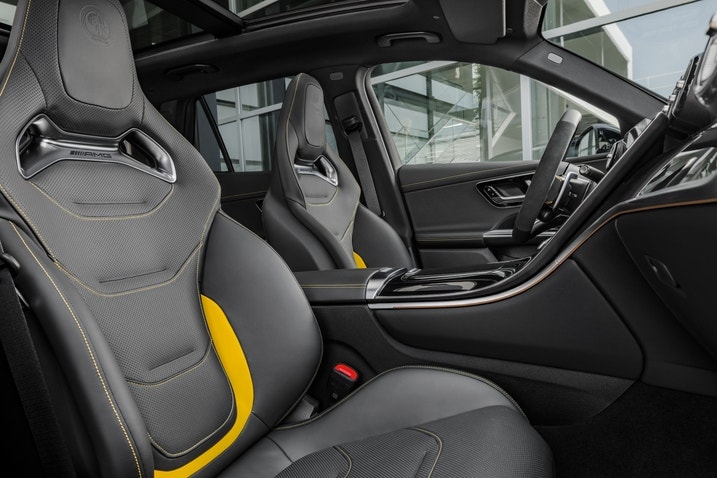- Two new powertrains join the Mercedes-Benz GLC lineup.
- Both use electrically assisted four-cylinder engines
- Range-topping GLC 63 S E Performance makes prodigious power but might leave drivers a bit cold.
Mercedes Debuts Two New High-Performance GLC Models, Including 671-HP Plug-In
Engines have a lot of tech to make all that power
The redesigned 2023 Mercedes-Benz GLC was just released, but some buyers might find its sole 255-horsepower engine a bit lacking in oomph. We think the GLC 300's 0-60 mph acceleration time of 6.1 seconds is pretty sprightly, but shoppers with a need for speed will want to wait a bit longer.
Beginning early next year, the 2024 Mercedes GLC will be available in a speedy AMG GLC 43 variant with 416 hp and 369 lb-ft of torque — good, Mercedes says, for cutting the 0-60 sprint time to 4.7 seconds. And later in the year, the 2025 AMG GLC 63 S E Performance will debut, powered by the same turbocharged 2.0-liter four-cylinder used in the GLC 300 and AMG GLC 43, but this time paired to a plug-in hybrid system. The powertrain produces a stonking 671 hp and 752 lb-ft of torque, making it far and away the most powerful small SUV on the market. Its estimated 0-60 time of 3.4 seconds makes it half a second quicker than the BMW X3 M, and a few ticks quicker than the Maserati Grecale Trofeo.
AMG GLC 43 adds a sporty flair
As with the related C-Class sedan, the GLC is going four-cylinder-only with this generation. That means the turbocharged V6 that used to drive the AMG GLC 43 is gone and replaced by a more potent version of the turbo-four from the GLC 300. We'll surely miss the six-cylinder's throaty growl, especially as the 0-60 mph time of 4.7 seconds is unchanged between generations. On one hand, it's a testament to the engineering of the AMG performance division — delivering the same performance from two fewer cylinders. This is partially due to an electric motor located within the turbocharger. Driven by the GLC's 48-volt mild hybrid system, the motor allows the turbo to spool faster than it could using exhaust pressure alone. The lower cylinder count might also translate to lower fuel consumption as well, though we should note that fuel economy figures are not yet available. On the other hand, it's a bummer that the needle hasn't moved forward in terms of outright acceleration.
The AMG GLC 43 also brings a handful of dynamic improvements, from standard adaptive dampers to a rear-axle steering system. The nine-speed transmission also features a clutch for taking off from a stop rather than a conventional torque converter, so you might feel a little hesitation off the line (similar to what you'd notice in a dual-clutch automatic). The exterior is further equipped with an aerodynamic body kit with large air inlets, vertical grille elements and quad exhaust tips to differentiate it from the workaday GLC 300.
Unique interior trim elements include front sport seats clad in imitation leather/faux suede upholstery and special graphics for the MBUX infotainment system. The AMG GLC 43 also comes with a flat-bottom AMG steering wheel with two dials that give the driver quick, easy access to altering drive mode settings.
AMG GLC 63 S E Performance: More words equals more faster
Under the AMG GLC 63's hood is a powertrain even more complex than the one in the GLC 43. It features the same M139l engine, but the turbocharger is larger, the electrical system is upgraded to 400 volts, and there's an electric motor positioned at the rear axle capable of delivering 107 hp continuously, or 201 hp in short bursts. That motor is connected to both a two-speed transmission and a 6.1-kWh battery pack — not huge by plug-in hybrid standards, but the GLC 63 isn't your typical PHEV. While the GLC 63 can travel in EV mode with a sufficiently charged battery, Merc says that performance is the battery's primary purpose, not range. Merc hasn't quoted EV range yet, but the smaller C 63 can only go 8 miles on a fully charged battery with the same capacity.
In contrast to the GLC 43, the GLC 63 is actually projected to be faster than its last-gen counterpart (we logged a 3.5-second sprint in an older GLC 63 Coupe), and we expect major fuel economy gains compared to the previous model's V8. But that engine was an absolute gem, with all manner of crackles, pops and roars. Even with the aural experience aside, we're wary of this advanced powertrain's ability to deliver a stimulating drive for what will likely be a nearly $100,000 price tag. We've driven a new AMG C 63 S E Performance and came away underwhelmed. In that vehicle, full power is only available in a single particular drive mode, and the newly standard all-wheel-drive configuration means that tail-out antics are few and far between. That last bit isn't as relevant to the GLC 63, where AWD has been part of the equation since its inception, but we do expect it will exhibit some of the C 63's less appealing attributes, like handling abilities impacted by a major weight gain between generations.
Like the GLC 43, this high-performance SUV features adaptive dampers and rear-axle steering, along with electrically controlled active anti-roll bars, bigger brakes and additional drive modes. And while the GLC 43 has a permanent 31%/69% power split between front and rear axles, the GLC 63 can vary output from 50%/50% at the front and rear to 100% at the rear. The GLC 63's interior matches that of the GLC 43, though the 63's leather-wrapped steering wheel features faux suede elements on the 3- and 9-o'clock positions.
Edmunds says
The 2024 Mercedes-Benz AMG GLC 43 and 2025 AMG GLC 63 S E Performance add needed spice to the GLC lineup. But while the four-cylinder underhood is technically impressive, we haven't fallen in love with it in other applications.









 by
by